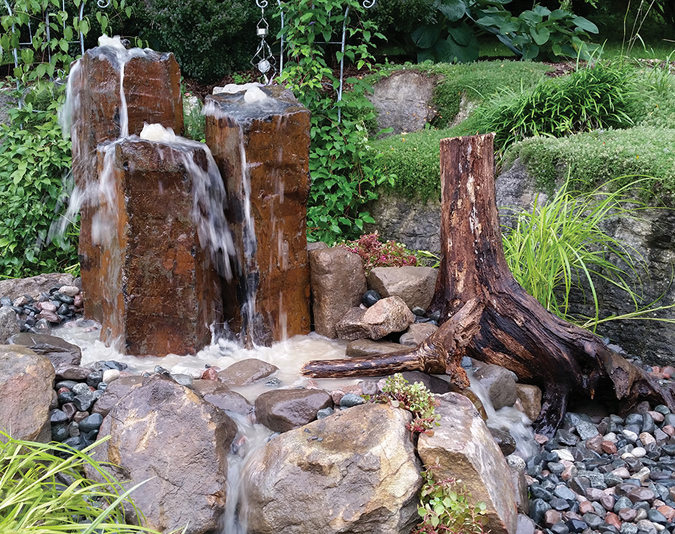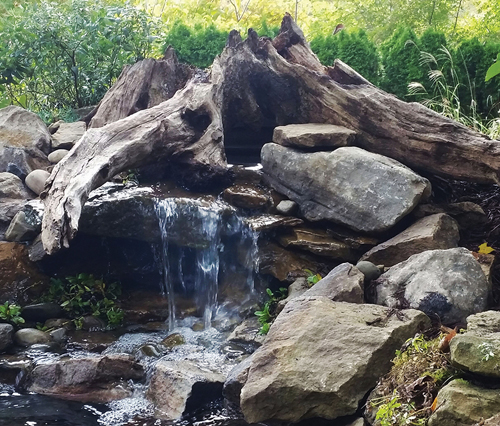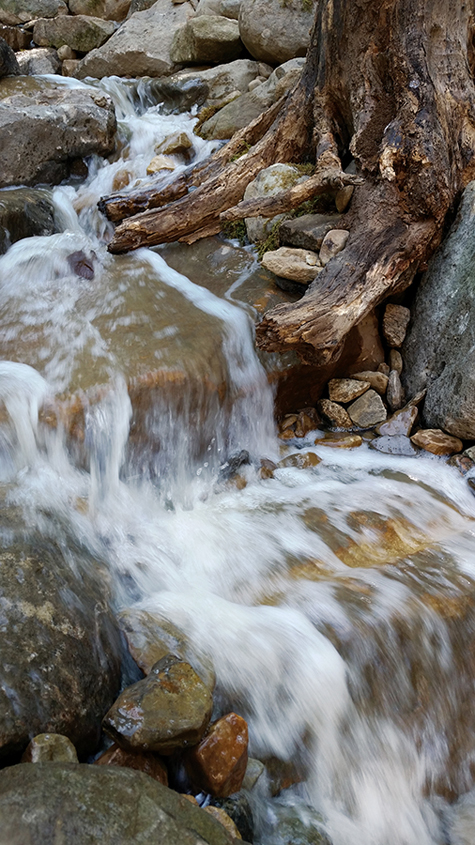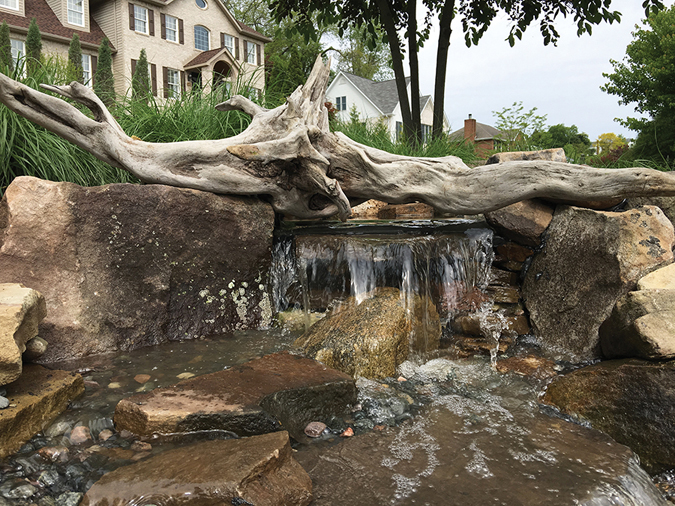
If you’re reading this magazine, chances are you’re at some point of your professional pond-contracting career. And I’d guess that the odds are also pretty good that, just like I, you are continually looking for ways to improve your craft. In this article we are going to talk about ways to utilize some of your local natural materials to add the perfect finishing touches to the water features you love to create. Specifically, we will be talking mostly about wood elements — driftwood, stumps and logs.
[box] >> View all images from this feature on POND’s Gallery Spotlight[/box]
Finding the perfect balance between function and design is a struggle for many contractors. Most of us build ponds using boulders or some other type of stone work. We also like to add plantings in and around water features for added filtration and beauty. But sometimes the mix of hard materials such as stone and soft materials like plants can look out of place if not designed properly. It can almost feel like an unnatural meshing of two extremes.
So Why “Wood” You?
Wood is an amazingly versatile material in water feature aesthetics. I like to think of it as a medium — just like a psychic is supposedly a medium between the real world and the spiritual world, wood can serve as an aesthetic medium between the stones and plantings. Wood offers the perfect balance of characteristics: hard, with an organic, earthy texture. It can be a functional and structural component like stone, yet it is not such a cold, hard material. I find that simply placing between one and three wood elements in a small or mid-sized water feature adds just enough medium to bridge the gap between hard and soft materials.Let’s go over the different types of wood elements that may be available to pond builders around the country.
Driftwood

It often has a smooth appearance due to many years of weathering in the sun and water. This is advantageous particularly if your goal is to build a pond that looks like it has been in the ground forever. Try placing a piece of driftwood strategically in a stream or waterfall to create the illusion that it has been weathered by the water’s current.
Stumps
These are my personal favorite. A good stump can be difficult to find! I’ve found nice stumps in various places, such as an old fence row on a farm, along the side of a country road and in the middle of the woods. Many you come across will be either too hard to get out of the ground or too soft to move without crumbling.
A perfect stump in my eyes comes from just the right recipe. A tree between 6 and 18 inches in diameter was cut down decades ago. The stump was left in the ground with about a foot or more of trunk standing. The exposed cut end has weathered considerably. The main roots are still intact and relatively solid, yet they easily break a couple of feet from the trunk. A little rocking back and forth should free the stump from its earthly confines, and voila — you have a beautiful piece of water feature art to use.

Stumps look great when integrated at the water line. Place a stump beside the stream so the flowing water just tickles the roots. Or try submerging the roots a few inches below the pond surface to add a new habitat for fish and frogs.
Logs
You never know when you’ll come across an interesting log. I’ve found some pretty sweet pieces behind a customer’s home in a wood pile. When it comes to logs, I like to find the really gnarly-looking ones. Hollow sections, mushrooms, moss growth and nubs from old branches can add a lot of character. Out of the three types of wood discussed in this article, logs can offer some of coolest features but will come with the trade-off of being relatively soft and susceptible to rot. I’ve found that you have to make a firm decision regarding each individual piece you may want to use. I weigh the artistic factor of the log against the predicted amount of time that it will stay structurally viable. If I think a log is going to last only about five years before crumbling, I still might use it if it looks really cool. On the other hand, if a particular log is only marginally appealing aesthetically, I might just leave it in the woods as opposed to using it in a water feature since it would need to be replaced in a few years.
Logs can make amazing standalone water features or can be incorporated around a pond’s edge. Hollow logs look especially great if they have some water flowing through them. Soft logs are not recommended inside a pond, as they deteriorate rather quickly with potentially adverse effects on the water clarity.
Before You Harvest
Not all ponds and water features will benefit from using wood elements, but a lot of them can. Proper selection of the right type of wood for each situation is very important. Consider the style of feature you are building. Wood elements are perfect for naturalized styles, but the right piece can also a be a tremendous addition to a more formal feature.
Educate your customers on the realistic expectations of wood elements you plan to use. Some of them will be leery, thinking that the wood will rot extremely quickly and ruin their pond. Discuss what you will do for them if the wood doesn’t last as long as you think it will. Will you replace it for free with a similar piece, or will you charge for it? Will you remove the wood and add stone or plantings in its place? Depending on the intricacy of your design, you may or may not be able to swap out a soft log for a newer one.
Stumps and logs have a strong tendency to add tannins to the water. Depending on the size of your water feature and the amount of water flowing over the wood piece, this may or may not become an issue for your customer. Driftwood is usually more stable and less prone to causing discolored water.

The softer the wood piece, the more it can wick water out of a pond. If you install a log that is half in water and half on dry ground, expect some level of wicking and water loss.
Don’t overlook smaller pieces of wood like bark and small branches. You can use waterfall foam to adhere them to the lip of a spillway, an exposed light fixture or other materials you wish to hide. Check your local and state regulations if you are thinking about harvesting driftwood, stumps or logs from nature. Transporting wood across state lines may be illegal. State and national forests are probably not good areas for harvesting wood due to various regulations.
I love experimenting with different ways to use wood elements in water features. I think it is a great way to add a one-of-a-kind, completely customized touch to an installation. My goal is usually to make water features look as natural as possible, and the perfect driftwood, stump or log is a key component of my success.
[box] >> View all the images for this feature on POND’s Gallery Spotlight[/box]



I am building a small pond for our turtles, and maybe some fish. It is currently 6X9 feet and about 2 feet deep. As I was digging, we came across a tree stump, and while digging it out, decided we liked the way the stump and roots looked and want to keep it. We have a Smartpond liner to use, but have been reading up on bentonite clay lining as well. My question, is can I use pond foam to seal the liner around the stump and roots? I have also seen some pond sealers and tape used when joining pond liners together, but I think the foam would work best when sealing around the stump?
We have been given some quotes from local pond builders, and we are not afraid to pay the amount asked, but we have not been living in our new home a full year yet, and I am not sure of the permanent location for our pond yet. Hence us doing it ourselves for starters. Any advice would be appreciated. I have not tried pulling the stump completely out yet, but I suppose I could and then lay it all on top of the liner? Maybe that is easier then cutting the liner and sealing around the roots and stump?